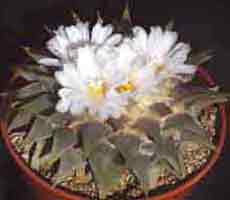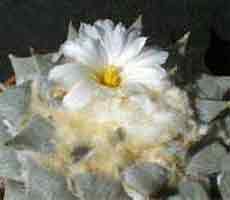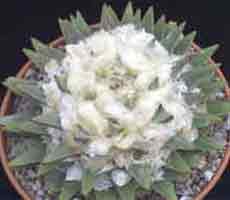|
Ariocarpus retusus
is an extremely variable
species, the most interesting variant being the Aramberri form, The diversity of the species is
illustrated here also by the A-F forms
offered by Mesa Garden, plants of which are now widely distributed
in cultivation.
Original
Publication
Ariocarpus retusus
Scheidweiler, (1838) Bull. Acad. Sci.
Brux. 5: 492
Description
Plant grey, or blue-green, rising slightly above
ground level, globose, rounded on top, 3-12cm high, 10-25cm in
diam.; tubercles divergent, erect, crowded and basally compressed,
usually becoming attenuate at the apices, convex or nearly
flattened adaxially and often with shallow adaxial undulations
or wrinkling, not
fissured, 1.5-4cm long, 1-3.5cm broad, nearly as broad as long;
spine-bearing portions of the areoles at the tips of the tubercles,
rounded, 1-5mm in diam.; flowers 4-5cm in diam., 2-4 2cm long;
outer perianth parts white, occasionally with reddish midribs,
1.2-2cm long, 5-8mm broad; inner perianth parts white or rarely
magenta, 1.4-2cm long, 5-9mm broad; pistil not exerted above the
stamens; style 1.4-2.1cm long; stigmas 7-16, 2.5-9mm long; fruit
white, green, or rarely pinkish, 1025mm long, 3-10mm in
diam.

A typical plant of the species
flowering in October
|
|
Distribution (Map)
Ariocarpus retusus, is along
with Ariocarpus kotschoubeyaanus, one of the most widely
distributed species in the genus, It ranges from north of Saltillo,
Coahuila southwards to San Luis Potosi, SLP, the easterly limits of
the species occur in Tamaulipas, populations are also found in
Zacatecas and Nuevo Leon. A retusus ssp. retusus is a
plant of the high Chihuahuan desert occurring at altitudes of
between 1300 and 2000 metres, on calcareous hillsides and
occasionally gypsum plains. At lower altitudes (200 - 800m) of the
Sierra Madre Oriental it is replaced by A. retusus ssp.
trigonus.
|
|
Comments
This species, the type of the genus is, as
might be expected with such a wide distribution range is highly
polymorphic. Tubercle size and shape vary widely, a terminal areole
may or may not be present, flower color ranges from white to pink,
or even bicolored (see The Aramberri
Enigma). The range of variation has been further increased by
the reduction of A. trigonus to sub-specific rank under
A. retusus by Anderson. The vast amount of phenotypic
variation in the species has led to the erection of several
variants, A. furfuraceus, has been applied to plants
with equilaterally triangular shaped tubercles, A
furfuraceus var. rostratus refers to plants with a more tapered
apex to the tubercle.
|
|

Ariocarpus retusus
'furfuraceus', with equilaterally triangular
tubercles
|

A. retusus
'scapharostroides', a recently described variant
|
|
The most recently described variants
are A. confusus, discussed here separately (The Aramberri Enigma), and A. retusus var.
scapharostroides both published by Halda & Horacek in
1998. A. retusus var. scapharostroides is based on
plants from the Villa Juarez region of SLP, it is characterized by
erect angular tubercles, superficially reminiscent of A.
scaphirostris, this variety awaits further evaluation but would
appear to represent just another variant of the A. retusus
complex. Seed of this plant is available under the field number
PP232, the plant offered by Mesa Garden as A. retusus form A
also equates to A. retusus var. scapharostroides.
Other recently published names associated with this species are
A. retusus subsp. jarmilae, A. retusus subsp.
horaceki, and A. retusus subsp. panarottoi. A retusus
var mnimus is a nomina nuda which has recently been applied to
plants from Echido Nuncio,in San Luis
Potosi.
|
Ariocarpus retusus is of easy culture in a well
drained calcareous clay compost, with ample water during the
growing season. It is probably the easiest species of the genus to
raise from seed, but will generally take about 10 years to reach
flowering size under United Kingdom conditions.
Field Numbers
A full listing
of all associated field data can be found on the field number reference pages.
|